USDA Regulated Pest
Japanese beetle
Family: Scarabaeidae Subfamily: Rutelinae Genus: Popillia Species: Popillia japonica Newman, 1838
DNA barcode available: specimen information; sequence file
Total body length 9.0–13.7 mm (0.35–0.54 in). Body oval-shaped. Color shining green, sometimes with reddish sheen; elytraelytra:
the hardened and chitinous wing-cover of a beetle that protect and overlie the flight wing
shiny brownish. Clypeusclypeus:
part of the head anterior to the frons; the most anterior portion in dorsal view
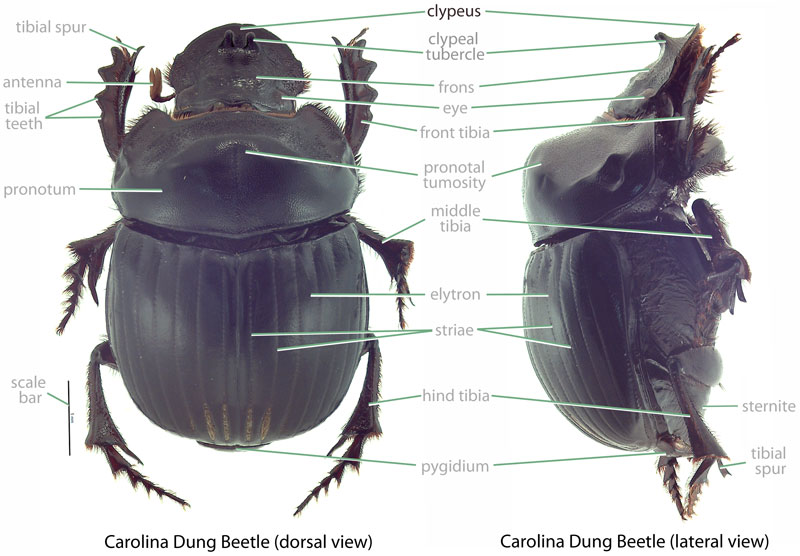 slightly narrowed toward strongly recurvedrecurved:
slightly narrowed toward strongly recurvedrecurved:
bending backwards
apexapex:
point or edge furthest from the body
. Front claw toothed; male with toothed claw more robust than in female. Pronotumpronotum:
the dorsal surface of the thorax
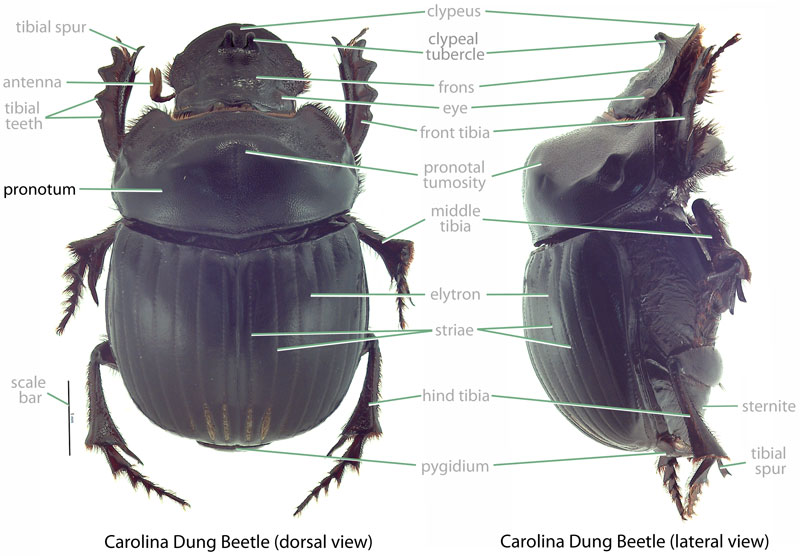 with dense punctationpunctation:
with dense punctationpunctation:
relating to a punctate surface texture
near anterioranterior:
the front or forward; opposite of posterior
border; punctures distinct. Pygidiumpygidium:
the last abdominal segment, usually exposed, not completely covered by the elytra
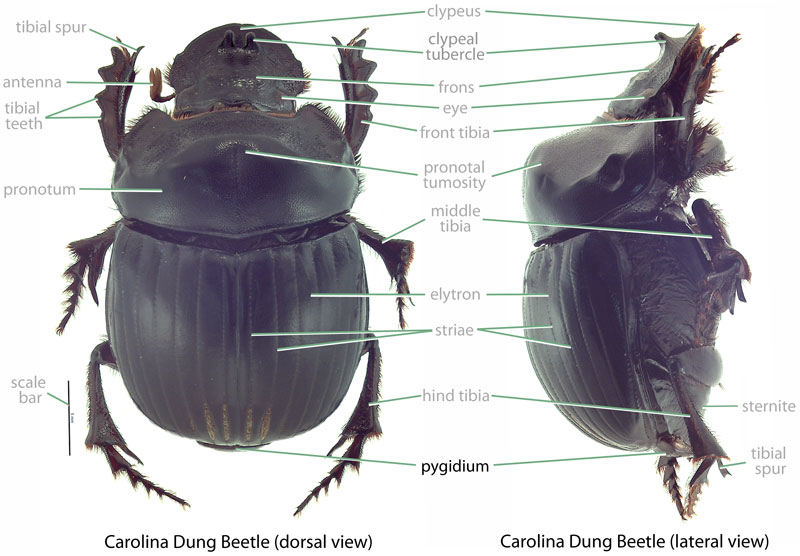 with 2 vaguely oval-shaped patches formed by dense whitish hairs (sometimes absent in worn specimens).
with 2 vaguely oval-shaped patches formed by dense whitish hairs (sometimes absent in worn specimens).
(Ritcher, 1966Ritcher, 1966:
Ritcher P. 1966. White grubs and their allies: a study of North American scarabaeoid larvae. Oregon State University Monographs, Studies in Entomology 4: 1-219.): Grub C-shaped, not hump-backed, cylindrical, whitish. Maxillamaxilla:
set of paired mouthparts located posterior to the mandibles
with galeagalea:
outer branch or lobe of the maxilla
 and lacinialacinia:
and lacinialacinia:
inner portion of the maxilla fused or nearly so. Fronsfrons:
fused or nearly so. Fronsfrons:
part of the head generally positioned between the eyes (posterior to the clypeus and anterior to the vertex) and visible dorsally
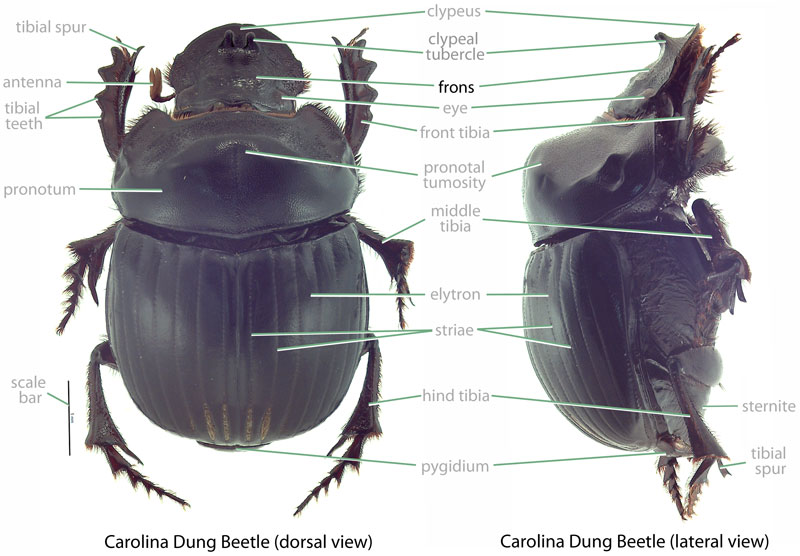 lacking numerous punctures. Labrumlabrum:
lacking numerous punctures. Labrumlabrum:
upper lip that covers the mandibles and is located ventrally relative to the clypeus
 asymmetrical. Claws sharply pointed. Dorsa of 9th and 10th abdominal segments not fused. Spiraclesspiracles:
asymmetrical. Claws sharply pointed. Dorsa of 9th and 10th abdominal segments not fused. Spiraclesspiracles:
opening on the abdomen or thorax through which air enters and exits the body
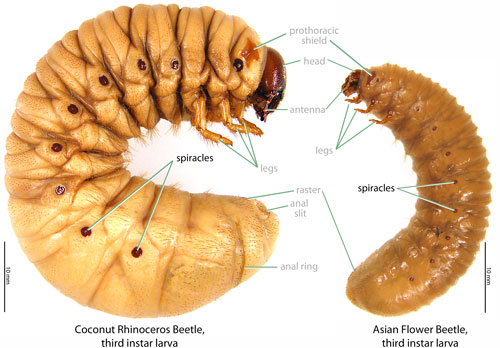 on 7th and 8th abdominal segments nearly equal in size. Segments 7–9 with dorsa with most of setaesetae:
on 7th and 8th abdominal segments nearly equal in size. Segments 7–9 with dorsa with most of setaesetae:
small, hair-like structure
confined to 2 transversetransverse:
extending horizontally across a surface
bands. PalidiaPalidia:
paired group(s) of recumbent (reclining) spines, usually occurring in rows; part of the raster
present, each palidiumpalidium:
paired group(s) of recumbent (reclining) spines, usually occurring in rows; part of the raster
with 5-8 palipali:
in scarab larvae, a straight, pointed spine, particularly as relates to the raster
. PaliPali:
in scarab larvae, a straight, pointed spine, particularly as relates to the raster
depressed or conical, never compressed. Venter of last abdominal segment with 14 or more preseptular hooked setaesetae:
small, hair-like structure
. Septulaseptula:
narrow bare area(s) of raster
triangularly-shaped. Preseptular, hamatehamate:
hook-like in shape
setae 35–57 in number. Lower anal lip with 19–29 long and short, straight setaesetae:
small, hair-like structure
.
Japan. This species is native to Japan, occurring on the four main islands of Honshu, Hokkaido, Kyushu, and Shikoku, but not the subtropical Ryuku Islands. This species is also known from the Russian Far East, specifically the islands of Sakhalin and Kunashir (Klein, 2008Klein, 2008:
Klein M. 2008. Popillia japonica (Japanese beetle). Invasive Species Compendium. Wallingford, UK, CAB International. Available from http://www.cabi.org/isc/datasheet/43599 (accessed April 20 2015).). Records from Korea and China are misidentifications of the similar four spotted beetle (Popillia quadriguttata) (Lee et al., 2007Lee et al., 2007:
Lee D, Choo H, Smitley D, Lee S, Shin H, Kaya H, Park C, Park J. 2007. Distribution and adult activity of Popillia quadriguttata (Coleoptera: Scarabaeidae) on golf courses in Korea. Journal of Economic Entomology 100: 103-109. DOI: doi.org/10.1603/0022-0493(2007)100[103:DAAAOP]2.0.CO;2).
Popillia japonica feeds on a broad array of flowering plants. Over 300 plant species are recorded as hosts (Vittum et al., 1999Vittum et al., 1999:
Vittum P, Villani M, Tashiro H. 1999. Turfgrass insects of the United States and Canada. Cornell University Press, Ithaca, NY, USA. 422 p.). Amongst economically important plants, major hosts include maples (Acer spp.), asparagus (Asparagus officinalis), soybean (Glycine max), apples (Malus spp.), stone fruit including plums, peaches, etc. (Prunus spp.), rhubarb (Rheum x hybridum), roses (Rosa spp.), blackberry and raspberry (Rubus spp.), basswood (also known as linden or lime trees) (Tilia spp.), elms (Ulmus spp.), grapes (Vitis spp.), and corn (Zea mays) (Gyeltshen and Hodges, 2005Gyeltshen and Hodges, 2005:
Gyeltshen A and Hodges A. 2005. Popillia japonica Newman (Insecta: Coleoptera: Scarabaeidae). University of Florida, Featured Creatures. Available from http://entnemdept.ufl.edu/creatures/orn/beetles/japanese_beetle.htm (accessed 2015).). Secondary hosts include buckeyes (Aesculus spp.), hollyhocks (Althaea spp.), birches (Betula spp.), chestnuts Castanea spp.), rosemallows (Hibiscus spp.), American walnut (Juglans nigra), plane trees and sycamores (Platanus spp.), poplars (Populus spp.), willow (Salix spp.), common sassafras (Sassafras albidum), and American mountain ash (Sorbus americana) (Gyeltshen and Hodges, 2005Gyeltshen and Hodges, 2005:
Gyeltshen A and Hodges A. 2005. Popillia japonica Newman (Insecta: Coleoptera: Scarabaeidae). University of Florida, Featured Creatures. Available from http://entnemdept.ufl.edu/creatures/orn/beetles/japanese_beetle.htm (accessed 2015).). LarvaeLarvae:
the immature form of an insect; in scarabs, also called grub or white grub; preceded by the egg stage, followed by the pupal stage
 feed on the roots of many of the same plants that adults defoliate and also damage the roots of many turf grass species (Klein, 2008Klein, 2008:
feed on the roots of many of the same plants that adults defoliate and also damage the roots of many turf grass species (Klein, 2008Klein, 2008:
Klein M. 2008. Popillia japonica (Japanese beetle). Invasive Species Compendium. Wallingford, UK, CAB International. Available from http://www.cabi.org/isc/datasheet/43599 (accessed April 20 2015).).
Because of its pest status, the lifecycle of the Popillia japonica is well known. In the eastern U.S., adults first emerge from pupation between May and July, and females begin laying eggs soon thereafter (Gyeltshen and Hodges, 2005Gyeltshen and Hodges, 2005:
Gyeltshen A and Hodges A. 2005. Popillia japonica Newman (Insecta: Coleoptera: Scarabaeidae). University of Florida, Featured Creatures. Available from http://entnemdept.ufl.edu/creatures/orn/beetles/japanese_beetle.htm (accessed 2015).). Females lay as many as 60 eggs (Klein, 2008Klein, 2008:
Klein M. 2008. Popillia japonica (Japanese beetle). Invasive Species Compendium. Wallingford, UK, CAB International. Available from http://www.cabi.org/isc/datasheet/43599 (accessed April 20 2015).) that are deposited 5.0–7.6 cm (2.0–3.0 in) deep in the soil, often under turf. Most larvaelarvae:
the immature form of an insect; in scarabs, also called grub or white grub; preceded by the egg stage, followed by the pupal stage
 reach their final instarinstar:
reach their final instarinstar:
in scarabs, one of the three larval growth phases (i.e., first instar, second instar, third instar), each ending with the larvae molting to the next phase
by September, burrowing as deep as 25.0 cm (10.0 in) to escape falling soil temperatures. Once temperatures fall below 10° C (50° F), grubs cease activity and overwintering occurs. Grubs resume feeding in the spring, and pupation takes place 4 to 6 weeks after feeding resumes. Pupation, which occurs near the soil surface, takes between 1 and 3 weeks. Males often emerge a few days before females (Gyeltshen and Hodges, 2005Gyeltshen and Hodges, 2005:
Gyeltshen A and Hodges A. 2005. Popillia japonica Newman (Insecta: Coleoptera: Scarabaeidae). University of Florida, Featured Creatures. Available from http://entnemdept.ufl.edu/creatures/orn/beetles/japanese_beetle.htm (accessed 2015).). Adult lifespan and activity are highly dependent upon local weather conditions. In the southern part of their range in the U.S., P. japonica adults often emerge in May (Gyeltshen and Hodges, 2005Gyeltshen and Hodges, 2005:
Gyeltshen A and Hodges A. 2005. Popillia japonica Newman (Insecta: Coleoptera: Scarabaeidae). University of Florida, Featured Creatures. Available from http://entnemdept.ufl.edu/creatures/orn/beetles/japanese_beetle.htm (accessed 2015).), while in Minnesota, adults usually emerge in mid-July (Krischik, 2011Krischik, 2011:
Krischik V. 2011. Japanese beetle management in Minnesota. Minnesota Department of Agriculture, University of Minnesota Extension Service. Available from http://www.extension.umn.edu/garden/insects/find/japanese-beetles/ (accessed 2015).). Adults live between 30–45 days (Klein, 2008Klein, 2008:
Klein M. 2008. Popillia japonica (Japanese beetle). Invasive Species Compendium. Wallingford, UK, CAB International. Available from http://www.cabi.org/isc/datasheet/43599 (accessed April 20 2015).). Adults are most active during warm sunny weather, particularly around midday when they may be found feeding on exposed foliage (Gyeltshen and Hodges, 2005Gyeltshen and Hodges, 2005:
Gyeltshen A and Hodges A. 2005. Popillia japonica Newman (Insecta: Coleoptera: Scarabaeidae). University of Florida, Featured Creatures. Available from http://entnemdept.ufl.edu/creatures/orn/beetles/japanese_beetle.htm (accessed 2015).).
Severe. Though not a significant pest in its native Japan, this species is regarded as the single most destructive insect pest of lawns, gardens, and golf courses in the eastern U.S. (Klein, 2008Klein, 2008:
Klein M. 2008. Popillia japonica (Japanese beetle). Invasive Species Compendium. Wallingford, UK, CAB International. Available from http://www.cabi.org/isc/datasheet/43599 (accessed April 20 2015).). In 2000, the USDA estimated that $450 million were spent annually in the U.S. on Popillia japonica control (Potter and Held, 2002Potter and Held, 2002:
Potter D and Held D. 2002. Biology and management of Japanese beetles. Annual Review of Entomology 47: 175-205.). Adults and larvaelarvae:
the immature form of an insect; in scarabs, also called grub or white grub; preceded by the egg stage, followed by the pupal stage
 are both destructive pests. Adults defoliate a vast variety of plants, often congregating on a single plant, attracted by aggregating pheromones. Once a host plant is chosen, the beetles feed on foliage, stems, and flowers. LarvaeLarvae:
are both destructive pests. Adults defoliate a vast variety of plants, often congregating on a single plant, attracted by aggregating pheromones. Once a host plant is chosen, the beetles feed on foliage, stems, and flowers. LarvaeLarvae:
the immature form of an insect; in scarabs, also called grub or white grub; preceded by the egg stage, followed by the pupal stage
 feed upon grass roots and are serious turf pests (Krischik, 2011Krischik, 2011:
feed upon grass roots and are serious turf pests (Krischik, 2011Krischik, 2011:
Krischik V. 2011. Japanese beetle management in Minnesota. Minnesota Department of Agriculture, University of Minnesota Extension Service. Available from http://www.extension.umn.edu/garden/insects/find/japanese-beetles/ (accessed 2015).). In California, this species has established populations at least three times. Fortunately, subsequent eradication was successful (Potter and Held, 2002Potter and Held, 2002:
Potter D and Held D. 2002. Biology and management of Japanese beetles. Annual Review of Entomology 47: 175-205.). In California, the beetle is regarded as a class A regulated pest, with a high likelihood of future introduction (Cosner, 2013Cosner, 2013:
Cosner C. 2013. Invasive species pathway risk analysis for California. PhD dissertation, University of California, Davis, California. full text (accessed 2015)). It is also listed as a quarantine pest in six other states, the Canadian province of British Columbia, and by the European and Mediterranean Plant Protection Organization (Potter and Held, 2002Potter and Held, 2002:
Potter D and Held D. 2002. Biology and management of Japanese beetles. Annual Review of Entomology 47: 175-205.).
Recorded, not established. While not established in Hawaii, this species has been intercepted repeatedly in quarantine on Oahu (Nishida, 2002Nishida, 2002:
Nishida G (editor). 2002. Hawaiian terrestrial arthropod checklist, fourth edition. Bishop Museum Technical Report 22: 1-313.). The earliest of numerous records dates to 1925, when a single male was found on air cargo coming into Honolulu from Japan (Rainwater, 1963Rainwater, 1963:
Rainwater H. 1963. Agricultural insect pest hitchhikers on aircraft. Proceedings of the Hawaiian Entomological Society 18: 303-310. full text (accessed 2015)). Further interceptions took place in 1954, when 18 live adults were found over the course of a month on aircraft flying into Honolulu from East Asia. In 1955, eight specimens were intercepted on five different aircraft flying into Hickham Airforce Base from Tokyo, Japan (Hawaiian Entomological Society, 1954Hawaiian Entomological Society, 1954:
Anonymous. 1954. Proceedings of the Hawaiian Entomological Society for the year 1954. Proceedings of the Hawaiian Entomological Society 15: 373-390. full text (accessed 2015)). In fact, between 1951 and 1959, 153 specimens were found by USDA inspectors (Hawaiian Entomological Society, 1961Hawaiian Entomological Society, 1961:
Anonymous. 1961. Notes and exhibitions. Proceedings of the Hawaiian Entomological Society for the Year 1961. 18: 14. full text (accessed 2015)).
Not established or recorded. No records of this species on Guam exist (this may reflect a lack of documentation), though the closely related Popillia lewisi is established on the island (Marler and Moore, 2011Marler and Moore, 2011:
Marler T and Moore A. 2011. Military threats to terrestrial resources not restricted to wartime: a case study from Guam. Journal of Environmental Science and Engineering 5: 1198-1214. full text (accessed 2015)).
Popillia japonica has been recorded hitchhiking on both air and marine cargo. The original introduction to the U.S. took place in the 1910's (Ritcher, 1966Ritcher, 1966:
Ritcher P. 1966. White grubs and their allies: a study of North American scarabaeoid larvae. Oregon State University Monographs, Studies in Entomology 4: 1-219.). It is believed that the initial introduction occured when an iris bulb shipment that hosted eggs or larvaelarvae:
the immature form of an insect; in scarabs, also called grub or white grub; preceded by the egg stage, followed by the pupal stage
 was imported via a ship from Japan (Klein, 2008Klein, 2008:
was imported via a ship from Japan (Klein, 2008Klein, 2008:
Klein M. 2008. Popillia japonica (Japanese beetle). Invasive Species Compendium. Wallingford, UK, CAB International. Available from http://www.cabi.org/isc/datasheet/43599 (accessed April 20 2015).). Records in Hawaii indicate that this species has been intercepted in air cargo on multiple occasions (Rainwater, 1963Rainwater, 1963:
Rainwater H. 1963. Agricultural insect pest hitchhikers on aircraft. Proceedings of the Hawaiian Entomological Society 18: 303-310. full text (accessed 2015)). While parts of the western U.S. are suitable habitat, as illustrated by California introductions, it is unclear if Hawaii and Guam have optimal climates for P. japonica proliferation. Indeed, despite clear evidence that P. japonica has reached the islands, it has never established a self-sustaining population. In the eastern U.S., this species has never spread further south than Georgia, and it is absent from Florida (Gyeltshen and Hodges, 2005Gyeltshen and Hodges, 2005:
Gyeltshen A and Hodges A. 2005. Popillia japonica Newman (Insecta: Coleoptera: Scarabaeidae). University of Florida, Featured Creatures. Available from http://entnemdept.ufl.edu/creatures/orn/beetles/japanese_beetle.htm (accessed 2015).). In Japan, this beetle is most common on the colder, northern islands of Honshu and Hokkaido (Klein, 2008Klein, 2008:
Klein M. 2008. Popillia japonica (Japanese beetle). Invasive Species Compendium. Wallingford, UK, CAB International. Available from http://www.cabi.org/isc/datasheet/43599 (accessed April 20 2015).). This may be due to the seasonal lifecycle of P. japonica. Perhaps the larval overwintering period is required for successful pupation.
Popillia japonica is very similar to both Popillia lewisi, established on Guam, as well as the potential invader Popillia quadriguttata. These three species can be separated by examination of of the pronotal punctationpunctation:
relating to a punctate surface texture
(P. japonica with dense, distinct punctures near anterioranterior:
the front or forward; opposite of posterior
border versus P. lewisiwith sparse, small and indistinct punctures), pygidiumpygidium:
the last abdominal segment, usually exposed, not completely covered by the elytra
 (P. japonica with two vaguely oval-shaped patches of setaesetae:
(P. japonica with two vaguely oval-shaped patches of setaesetae:
small, hair-like structure
versus P. lewisiwith crescent-shaped patches), clypeusclypeus:
part of the head anterior to the frons; the most anterior portion in dorsal view
 (P. japonica with clypeusclypeus:
(P. japonica with clypeusclypeus:
part of the head anterior to the frons; the most anterior portion in dorsal view
 barely narrowing at apexapex:
barely narrowing at apexapex:
point or edge furthest from the body
, strongly recurvedrecurved:
bending backwards
versus P. quadriguttata and P. lewisi with clypeusclypeus:
part of the head anterior to the frons; the most anterior portion in dorsal view
 rounded, narrowing at apexapex:
rounded, narrowing at apexapex:
point or edge furthest from the body
, somewhat recurvedrecurved:
bending backwards
), and often size (P. japonica at 9.0–13.7 mm [0.35–0.54 in] versus 11.0 mm [0.43 in] or less in P. quadriguttata and P. lewisi).
Popillia placatipennis Burmeister
Prevent the spread of this USDA regulated pest by reporting your observation at our iNaturalist project.